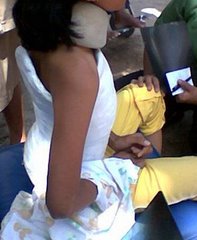Juvenile Rheumatoid Arthritis: Differential Diagnoses & Workup
| Fever in the Toddler | |
Other Problems to Be Considered
Many conditions may manifest with arthritis of brief duration. Postinfectious arthritis typically affects large joints. This syndrome is clinically indistinguishable from the early phase of juvenile idiopathic arthritis (JIA), particularly because onset of juvenile idiopathic arthritis may be triggered by viral infections; a duration longer than 6 weeks eventually differentiates juvenile idiopathic arthritis. Patients with acute lymphocytic leukemia can present with joint pain and arthritis. Expansion of lymphoblasts in bone metaphyses results in pain, which is typically severe and may awaken a child from sleep.
Thrombocytopenia is rare in persons with juvenile idiopathic arthritis; its presence also suggests the possibility of leukemia. The differential count in juvenile idiopathic arthritis often demonstrates a relative lymphopenia, presumably because of egress of activated lymphocytes from circulation into synovium. Lymphocytosis is uncharacteristic of juvenile rheumatoid arthritis and raises the possibility of leukemia, particularly when a neutropenia is present.
Enthesitis-related arthritis, or spondyloarthropathy, is a chronic disease characterized by periods of inflammation of tendons and ligaments, particularly at the area of insertion into bone (entheses). Often, children and adolescents with spondyloarthropathy present with arthritis, making the distinction between subtypes difficult. Furthermore, some children occasionally develop a disease that appears to be a combination of the 2 diseases. Nevertheless, although enthesitis can be observed in persons with pauciarticular and polyarticular juvenile rheumatoid arthritis, the eventual evolution of arthritis to a predominant enthesitis is more characteristic of spondyloarthropathy. The presence of the human leukocyte antigen (HLA) B27 is helpful in suggesting the diagnosis. However, radiographic changes observed in adults (eg, sclerosis of the sacroiliac joints, bamboo spine) are rare in childhood and adolescence.
No laboratory studies are diagnostic for juvenile idiopathic arthritis (JIA).
- All laboratory study findings may be normal in children with juvenile idiopathic arthritis. Diagnosis is based on the physical finding of arthritis. Laboratory studies help exclude other underlying diagnosis, classify the type of arthritis, and help evaluate for extra-articular manifestations of juvenile idiopathic arthritis. Initial evaluation should include the following:
- Inflammatory markers
- Erythrocyte sedimentation rate (ESR) or C-reactive protein (CRP) are usually elevated in children with systemic juvenile rheumatoid arthritis (JRA) and may be elevated or normal in those with polyarticular disease; however, it is often within the reference range in those with pauciarticular disease.
- When elevated, inflammatory markers may be used to monitor success of medical treatment.
- CBC count with differential and platelet count
- Lymphopenia is not uncommon because of emigration of activated lymphocytes out of the circulation into synovium.
- Neutropenia is uncommon and, particularly with lymphocytosis or thrombocytopenia, raises the possibility of acute lymphocytic leukemia.
- Thrombocytopenia may also be observed in persons with systemic lupus erythematosus (SLE) presenting with arthritis, as well as marrow occupying malignancies. Thrombocytosis reflects inflammatory state and often mirrors inflammatory markers in juvenile idiopathic arthritis.
- Anemia may result from chronic active juvenile rheumatoid arthritis; often microcytic, anemia is usually refractive to treatment with iron.
- Alanine aminotransferase (ALT) test: Obtain ALT levels to exclude the possibility of hepatitis (viral or autoimmune) prior to initiating treatment with nonsteroidal anti-inflammatory drugs (NSAIDs) or methotrexate (MTX), which can cause hepatotoxicity.
- Urinalysis with microscopic examination: Perform a urinalysis to exclude the possibility of infection (as a trigger of juvenile rheumatoid arthritis or transient postinfectious arthritis) and nephritis (observed in individuals with SLE). Urinalysis should be monitored in children on chronic NSAIDs. Serum creatinine levels should be obtained prior to initiation of treatment with NSAIDs.
- Antinuclear antibody (ANA)
- ANA is observed in as many as 50% of children with juvenile idiopathic arthritis, particularly in those with oligoarticular or polyarticular rheumatoid factor–negative subtypes.
- A positive ANA is a marker for increased risk of anterior uveitis. Children younger than 6 years at arthritis onset with a positive ANA finding are in the highest risk category for development of uveitis and need slit lamp screening every 3-4 months.
- Very high titers may sometimes be associated with evolution to other rheumatic disease (eg, SLE).
- Titers otherwise do not correlate with disease activity.
- Rheumatoid factor
- Rheumatoid factor is found to be present in less than 10% of children with juvenile idiopathic arthritis. It is very rarely found in those with systemic juvenile idiopathic arthritis. Rheumatoid factor is a marker for early erosive disease and persistence of arthritis into adulthood.
- Rheumatoid nodules may be seen in those with rheumatoid factor–positive disease
- Compared with adults who have rheumatoid factor, children are at less risk for rheumatoid lung involvement and vasculitis.
- Other laboratory tests for systemic juvenile rheumatoid arthritis include the following:
- Total protein and albumin levels are often decreased during active disease.
- Fibrinogen and D-dimer levels are often elevated in individuals with active disease.
- A falling sedimentation rate, along with normalization or falling WBC, low platelets, elevated liver function test findings, increased ferritin and triglycerides with low fibrinogen and associated erratic fevers, hemorrhages (disseminated intravascular coagulation–like pattern) are indicative of development of macrophage activating syndrome (MAS) in particularly in those with systemic onset juvenile idiopathic arthritis.
- Other laboratory tests to consider include the following:
- ACE elevation may be indicative of sarcoidosis.
- Antistreptolysin 0 (AS0) and anti-DNAse B elevations may indicate acute rheumatic fever or poststreptococcal arthritis.
The following imaging studies are indicated:
- Radiography of affected joints: When only a single joint is affected, radiography is important to exclude other diseases, such as osteomyelitis or septic arthritis.
- Bone scanning: When physical findings do not document definite arthritis, consider bone scanning as a means of identifying a potential focus of osteomyelitis or other abnormality.
- MRI
- Perform MRI of the affected joint, with gadolinium injection to enhance inflamed synovium.
- MRI is helpful when considering trauma in the differential diagnosis.
- MRI of the temporal-mandibular joint (TMJ) is useful in diagnosing TMJ inflammatory arthritis.
- CT scanning of long bones: Perform when considering osteoid osteoma in a child with lower extremity pain (often at night) and unremarkable findings on physical examination.
- Echocardiography
- This is performed in a child with possible systemic juvenile rheumatoid arthritis and with fevers.
- Perform echocardiography in an individual who has orthopnea by history or a rub to exclude pericarditis.
- In a person who has nonspecific rash, adenopathy, and possible mucocutaneous changes, perform echocardiography to exclude coronary arterial dilation resulting from (possibly atypical) Kawasaki disease.
- In an individual who has findings suggestive of SLE (eg, nephritis, pleuritic chest pain, thrombocytopenia), perform echocardiography to exclude valvular disease, although mild dilation may be seen in some patients with systemic juvenile rheumatoid arthritis.
Perform dual-energy radiograph absorptiometry (DXA) scanning to document osteopenia in children with polyarticular juvenile rheumatoid arthritis.
The following procedures are indicated:
- Arthrocentesis: Perform arthrocentesis to exclude septic arthritis in a child with monoarticular swelling.
- Synovial biopsy: This procedure may be helpful to exclude other diagnoses, particularly when the knee is affected (eg, villonodular synovitis, granulomatous arthritis).
- Pericardiocentesis: Perform this in an ICU setting to treat severe pericarditis.
Synovial biopsy may reveal synovial infiltration with plasma cells, mature B lymphocytes, and T lymphocytes, with areas of synovial thickening and fibrosis.








No comments:
Post a Comment